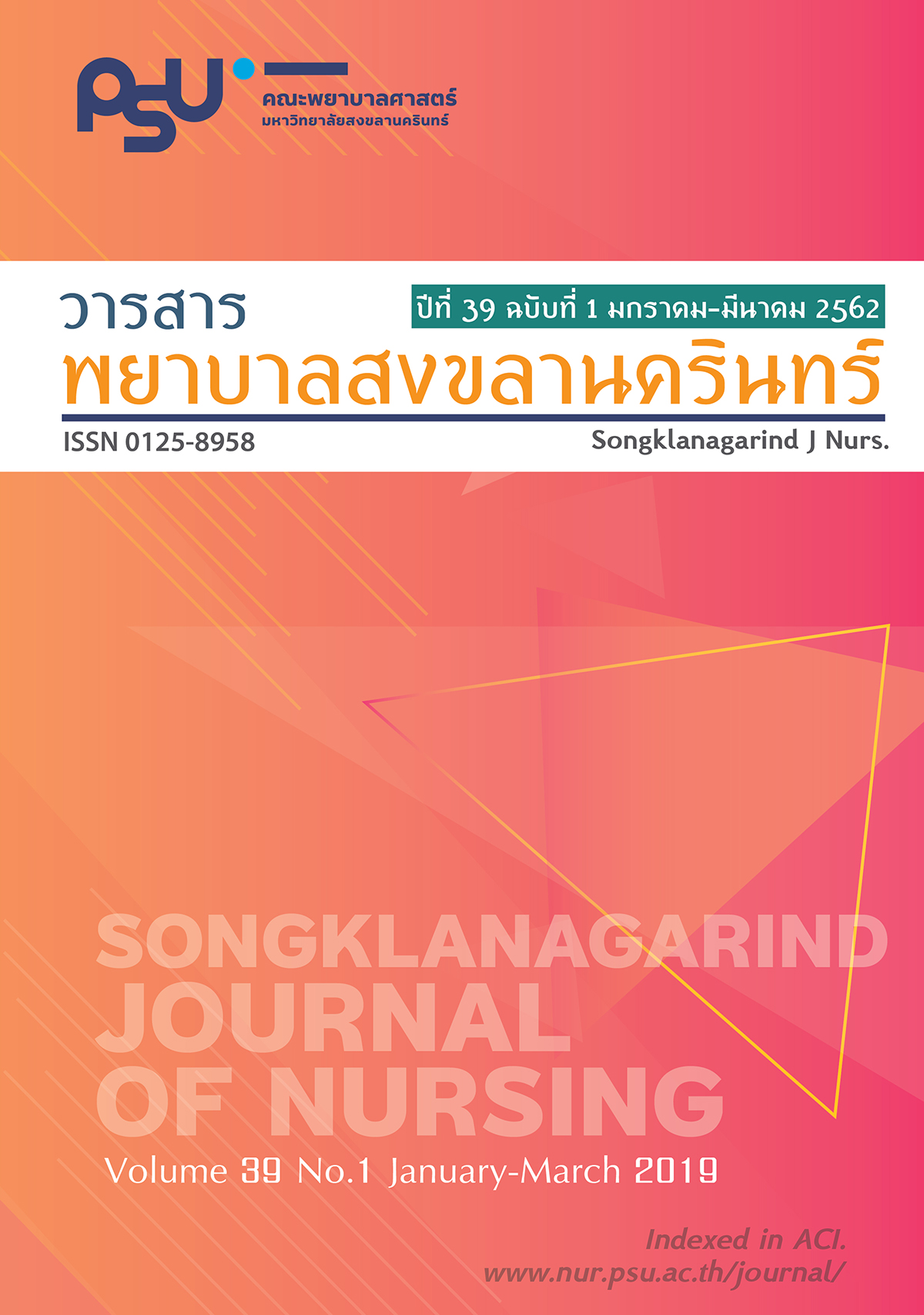Effects of the Leader Training Program on Communication, Decision Making, and Leadership Skills Among Adolescents with HIV/AIDS
Main Article Content
บทคัดย่อ
การฝึกวัยรุ่นที่ติดเชื้อเอชไอวี/เอดส์ เพื่อเป็นผู้นำในการฝึกอบรมเป็นสิ่งสำคัญยิ่ง เนื่องจากวัยรุ่นสามารถพูดคุยได้การฝึกวัยรุ่นที่ติดเชื้อเอชไอวี/เอดส์ เพื่อเป็นผู้นำในการฝึกอบรมเป็นสิ่งสำคัญยิ่ง เนื่องจากวัยรุ่นสามารถพูดคุยได้อย่างเปิดเผยและเข้าถึงกลุ่มเดียวกันได้ง่าย การศึกษาครั้งนี้เป็นการวิจัยกึ่งทดลองแบบหนึ่งกลุ่มวัดก่อนและหลัง มีวัตถุประสงค์เพื่อทดสอบผลของโปรแกรมฝึกผู้นำต่อทักษะการสื่อสาร การตัดสินใจ และการเป็นผู้นำของวัยรุ่นที่ติดเชื้อเอชไอวี/เอดส์ สุ่มกลุ่มตัวอย่างแบบเฉพาะเจาะจง จากวัยรุ่นที่ติดเชื้อเอชไอวี/เอดส์ และมารับการรักษา ณ คลินิกเอชไอวี/เอดส์ ของโรงพยาบาลศูนย์แห่งหนึ่งในภาคใต้ของประเทศไทย จำนวน 10 คน กลุ่มตัวอย่างได้รับโปรแกรมการฝึกผู้นำที่สร้างขึ้นโดยผู้วิจัย จากการผสมผสานแนวคิดทักษะการเป็นผู้นำ พัฒนาการทางสังคมของวัยรุ่นและอิทธิพลของกลุ่มเพื่อน ประกอบด้วย กิจกรรมสร้างสัมพันธภาพกระตุ้นให้แสดงพลังศักยภาพ ทักษะการสื่อสาร ทักษะการตัดสินใจและใช้สื่อสังคมออนไลน์ ใช้เวลาในการฝึกโดยผู้วิจัยทั้งแบบเผชิญหน้าและผ่านทางสังคมออนไลน์ (เฟชบุค) เป็นเวลา 3 วัน เก็บข้อมูลก่อนและหลังได้รับโปรแกรมฝึกผู้นำ โดยใช้แบบสอบถาม ประกอบด้วย 1) ข้อมูลส่วนบุคคล 2) ทักษะการสื่อสาร 3) ทักษะการตัดสินใจ และ 4) ทักษะการเป็นผู้นำซึ่งโปรแกรมและแบบสอบถามชุดที่ 2 ได้ขออนุญาตดัดแปลง ได้ผ่านการตรวจสอบความตรงตามเนื้อหาจากผู้ทรงคุณวุฒิ 3 ท่านแบบสอบถามชุดที่ 2-4 ได้ผ่านกระบวนการแปลย้อนกลับของเครื่องมือจากผู้ทรงคุณวุฒิ 4 ท่าน ทดสอบความเที่ยงของแบบสอบถามชุดที่ 2-4 ได้ค่าสัมประสิทธิ์แอลฟาของครอนบาค เท่ากับ .89, .88, และ .81 ตามลำดับ วิเคราะห์ข้อมูลโดยใช้สถิติพรรณนา และสถิติทีคู่
ผลการศึกษา พบว่า คะแนนเฉลี่ยของทักษะการสื่อสาร การตัดสินใจ และการเป็นผู้นำของวัยรุ่น หลังได้รับโปรแกรมการฝึกผู้นำ สูงกว่าก่อนได้รับโปรแกรมการฝึกผู้นำอย่างมีนัยสำคัญทางสถิติ (p< .001) ผู้นำวัยรุ่นทุกคน มีทักษะการเป็นผู้นำอยู่ในระดับดีเยี่ยมหลังได้รับโปรแกรมการฝึกผู้นำ ดังนั้น พยาบาลอาจนำโปรแกรมนี้ไปใช้ในการฝึกวัยรุ่นที่ติดเชื้อเอชไอวี/เอดส์ให้เป็นผู้นำที่มีประสิทธิภาพต่อไป
Article Details
เอกสารอ้างอิง
United Nations Programme on HIV/AIDS. Fact sheet - latest statistics on the status of the AIDS epidemic [Internet]. 2017 [cited 2018]. Available from: http://www.unaids.org/en/resources/ fact-sheet
Bureau of AIDS TB and STIs, Department of disease control, Ministry of Public Health. Thailand ending AIDS. Available from [Internet]. 2015 [cited 2017 December 5]. Available from: http://www./THA_ narrative_ report_2015.pdf Thai.
Bureau of AIDS, TB and STIs, Department of Disease Control, Ministry of Public Health. The asian epidemic model (AEM) projections for HIV/AIDS in Thailand: 2010-2030 [Internet]. 2018 [cited 2018 February 2]. Available from: http://www.aidsdatahub.org/dmdocuments/The_Asian_Epidemic_Model_Projections_for_HIVAIDS_in_ Thailand_2010_2030.pdf Thai.
Centers for Disease Control and Prevention. Sexually transmitted disease [Internet]. 2015. Available from: https://www.cdc.gov/std/tg2015/2015-pocket-guide.pdf
Mahat G, Scoloveno MA. HIV peer education: Relationships between adolescents’ HIV/AIDS knowledge and self-efficacy. J HIV/AIDS & Social Service. 2010; 9(4): 371-384.
Sanders RA. Adolescent psychosocial, social, and cognitive development. Pediatr Rev. 2013; 34(8): 554-359. doi:10.1542/pir.34-8-35
Hamdan S. The effectiveness of student leadership training programs in public universities of Malaysia. Ann Arbor: Idaho State University; 2006.
Katherine W. Early Leadership Training and Its Relationship to Communication Skills, Self-Esteem, and Problem Solving Skills among Adolescents. Ann Arbor: Northcentral University; 2018.
Ricketts JC, Rudd RD. A comprehensive leadership education model to train, teach, and develop leadership in youth. JCTE. 2002; 19(1): 517-526.
Thato R, Penrose J. A brief, peer-led HIV prevention program for college students in Bangkok, Thailand. J Pediatr Adolesc Gynecol. 2013;26(1): 58-65. doi:10.1016/j.jpag.2012.09.011
Fongkaew W, Settheekul S, Fongkaew K, Sura-pagdee N. Effectiveness of a youth-led educational program on sexual and reproductive health for Thai early adolescents. Pacific Rim Int J Nurs Res. 2011; 15(2): 81-96.
Medley A, Kennedy C, O’Reilly K, Sweat M. Effectiveness of peer education interventions for HIV prevention in developing countries: A systematic review and meta-analysis. AIDS Educ Prev. 2009; 21(3): 181–206. doi:10.1521/aeap. 2009.21.3.181.
Turner A. Generation Z: Technology and Social Interest. Journal of Individual Psychology [serial on the Internet]. (2015, Summer2015), [cited June 3, 2018]; 71(2): 103-113. Available from: Academic Search Complete.
Cingel D, Lauricella A, Wartella E, Conway A. Predicting social networking site use and online communication practices among adolescents: The role of access and device ownership. Media and Communication. 2014; 2(2): 1-30. doi:10.17645/mac.v2i2.122
Ministry of Digital Economy and Society. The impact of digital transformation on economy. Paper presented at the International Symposium and Exhibition “Digital Thailand 2017”[Internet]. 2017 [cited 2017 September 22]. Available from: https://www.digitalthailandbigbang.com/ 2017/09/22 Thai.
Young SD, Szekeres G, Coates T. Sexual risk and HIV prevention behaviors among African American and Latino MSM social networking users. Int J STD AIDS. 2013; 24(8), 1-11. doi: 10.1177/0956462413478875
Patricia ET. Understanding student leadership: A study of peer mediation training and program participation among middle and high school students. Ann Arbor: University of Massachusetts Lowell; 2001.
Marquis BL, Huston CJ. Leadership role and management functions in nursing theory and application. Philadelphia: Wolters Kluwer; 2015.
Burns JM. Leadership. New York: Harper & Row; 1978.
Riley JB. Communication in nursing. St. Louis, MO: Mosby Elsevier; 2012.
Stuart GW. Principles and practice of psychiatric nursing. St. Louis, MO: Mosby Elsevier; 2014.
Thompson C, Dowding D. Clinical decision making and judgement in nursing. Churchill, Livingstone: Edinburgh; 2002.
Sanders RA. Adolescent psychosocial, social, and cognitive development. Pediatr Rev. 2013; 34(8): 554-359. doi:10.1542/pir.34-8-35
Gullota PT, Adams RG, editors. Handbook of adolescents behavioral problems evidence- based approaches to prevent and treatment. New York: Springer; 2005.
Rogers E. M. Diffusion of innovations. 4th ed. New York: Free Press; 1995.
Bureau of AIDS TB and STI, Department of Disease Control, Ministry of Public Health. Thailand National Guidelines on HIV/AIDS Treatment and Prevention 2017. Bangkok: The agricultural co-operative federation of Thailand; 2017.
Danaher GB, Dresser J, Shaw T, Severson HH, Tyler SM, Maxwell DE, Christiansen MS. Development and process evaluation of a webbased responsible beverage service training program. Subst Abuse Treat Prev Policy. 2012; 7(41): 1-9.
Seropian AM, Brown K, Gavilanes SJ, Driggers B. An approach to simulation program development. J Nur Edu. 2004; 43(4); 170-174. doi:10.3928/01484834-20040401-02
Mind Tools Ltd Company. Mind tools material [Internet]. 2013. Available from: www.mindtools.com
Brislin, RW. The wording and translation of research instrument. Beverly Hills: Sage; 1986.
Brislin RW. The wording and translation of research instrument. In Lonner WJ, Berry JW. Editors. Field methods in cross-cultural research. Beverly Hills: Sage; 1986.
Kim H-Y. Statistical notes for clinical researchers: assessing normal distribution using skewness and kurtosis. Restor Dent Endod. 2013; 38(1), 52-54. doi:10.5395/rde.2013. 38.1.52
Hamdan S. The effectiveness of student leadership training programs in public universities of Malaysia. Ann Arbor: Idaho State University; 2006.
Jaganath D, Gill HK, Cohen AC, Young SD. Harnessing online peer education (HOPE): Integrating C-POL and social media to train peer leaders in HIV prevention. AIDS Care. 2012; 24(5): 593-600.


